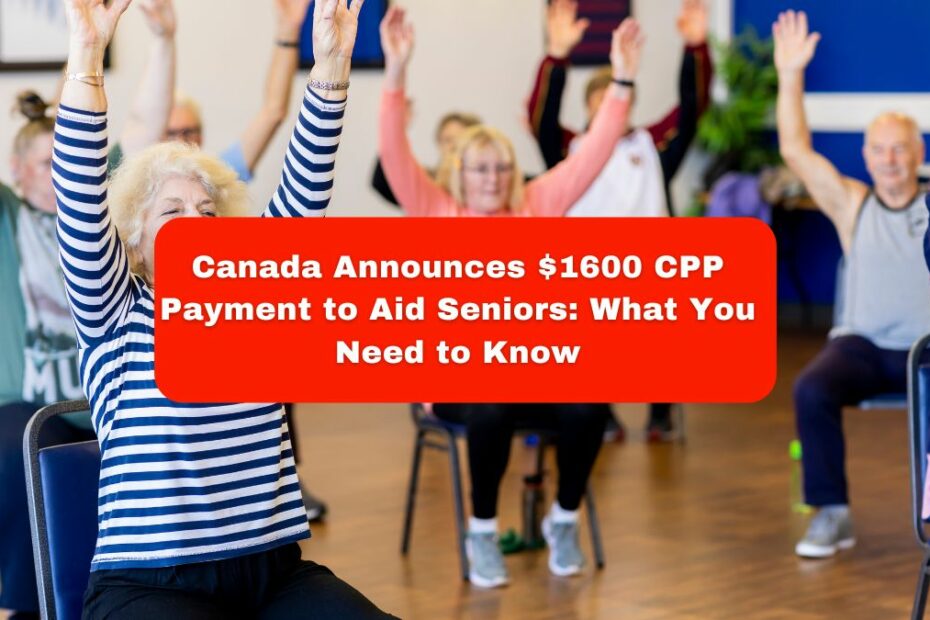The Canadian government has recently introduced a $1600 one-time payment under the Canada Pension Plan (CPP). This new initiative, announced by Finance Minister Chrystia Freeland, aims to provide financial support to senior citizens facing economic difficulties due to rising living costs and inflation. This article will cover the key aspects of this $1600 CPP payment, including eligibility criteria, payment dates, and important details you need to know.
New $1600 CPP Payment by Chrystia Freeland
Chrystia Freeland has announced a new $1600 payment under the CPP. This payment is designed to help pensioners who have reached retirement age and are struggling with higher living costs. It is important to note that this $1600 is a one-time payment, not a monthly increase. The government will deposit this amount directly into the bank accounts of eligible pensioners. If you are already receiving CPP payments, you do not need to apply separately for this boost.
$1600 CPP Fact Check
The $1600 CPP payment is tax-free and adjusted based on the Consumer Price Index (CPI) to match the current inflation rate and cost of living. The CPP payment amount has been increased by 4.4% to reflect high inflation. For example, if someone starts receiving their pension at age 65, they would typically get around $1364.60 per month, with the average new retirement pension amount being about $816.52 as of April.
$1600 CPP Eligibility
To qualify for the $1600 CPP payment, individuals must meet the following criteria set by the Canada Revenue Agency (CRA):
| Eligibility Criteria | Details |
|---|---|
| Contribution | Must have made at least one contribution to the CPP. |
| Age | Must be 65 years old or older. |
| Residency | Must be a resident of Canada. |
Eligibility criteria may change, so it’s important to stay updated through official government portals.
$1600 CPP Payment Dates
The $1600 CPP payment is expected to be issued to eligible seniors in July 2024. The exact dates will be announced by the government. Payments will be directly deposited into the bank accounts of eligible individuals. If you have not opted for direct deposit, you will receive a cheque in the last three business days of the month.
To track your payment status:
| Steps to Check Payment Status | Details |
|---|---|
| Visit Government Website | Go to the official Canadian government website. |
| Log In to Account | Use your Social Insurance Number (SIN) to log in. |
| Enter Required Details | Fill out the necessary information and log in. |
| Check Payment Status | View your payment status and verify details. |
All We Know
The $1600 CPP payment aims to support those in greatest need. Some factors affecting the pension amount include:
- If the individual is still working, they may be eligible for post-retirement benefits.
- The amount might be calculated based on low or no earnings during retirement.
- CPP contributions can be shared between divorced or separated couples.
Regularly check the official Canadian government website for updates and additional information on the Canada Pension Plan.
Summary
The $1600 CPP payment introduced by the Canadian government is a one-time financial boost to help seniors with increased living costs. Eligibility requires being a Canadian resident over 65 with at least one CPP contribution. Payments will start in July 2024 and will be deposited directly into bank accounts or issued as cheques. Stay informed by visiting official government portals regularly.
FAQ’s
What is the $1600 CPP payment?
The $1600 CPP payment is a one-time financial boost introduced by the Canadian government to assist seniors facing economic difficulties due to rising living costs and inflation.
Who is eligible for the $1600 CPP payment?
To be eligible, individuals must be at least 65 years old, have made at least one contribution to the CPP, and be a resident of Canada.
When will the $1600 CPP payment be issued?
The payment is expected to be issued in July 2024. Eligible seniors will receive it directly into their bank accounts, or as a cheque if they have not opted for direct deposit.
